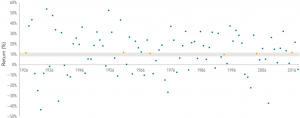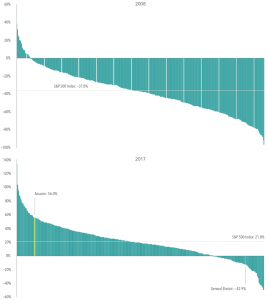The Uncommon Average
The US stock market has delivered an average annual return of around 10% since 1926.[1] But short-term results may vary, and in any given period stock returns can be positive, negative, or flat. When setting expectations, it’s helpful to see the range of outcomes experienced by investors historically. For example, how often have the stock market’s annual returns actually aligned with its long-term average?
Exhibit 1 shows calendar year returns for the S&P 500 Index since 1926. The shaded band marks the historical average of 10%, plus or minus 2 percentage points. The S&P 500 Index had a return within this range in only six of the past 93 calendar years. In most years, the index’s return was outside of the range—often above or below by a wide margin—with no obvious pattern. For investors, the data highlight the importance of looking beyond average returns and being aware of the range of potential outcomes.
Exhibit 1: S&P 500 Index Annual Returns
1926–2018

In US dollars. S&P data © S&P Dow Jones Indices LLC, a division of S&P Global. Indices are not available for direct investment. Index returns are not representative of actual portfolios and do not reflect costs and fees associated with an actual investment. Past performance is no guarantee of future results. Actual returns may be lower.
TUNING IN TO DIFFERENT FREQUENCIES
Despite the year-to-year volatility, investors can potentially increase their chances of having a positive outcome by maintaining a long-term focus. Exhibit 2 documents the historical frequency of positive returns over rolling periods of one, five, and 10 years in the US market. The data show that, while positive performance is never assured, investors’ odds improve over longer time horizons.
Exhibit 2: Frequency of Positive Returns in the S&P 500 Index
Overlapping Periods: 1926–2018

In US dollars. From January 1926–December 2018, there are 997 overlapping 10-year periods, 1,057 overlapping 5-year periods, and 1,105 overlapping 1-year periods. The first period starts in January 1926, the second period starts in February 1926, the third in March 1926, and so on. S&P data © S&P Dow Jones Indices LLC, a division of S&P Global. Indices are not available for direct investment. Index returns are not representative of actual portfolios and do not reflect costs and fees associated with an actual investment. Past performance is no guarantee of future results. Actual returns may be lower.
Conclusion
While some investors might find it easy to stay the course in years with above average returns, periods of disappointing results may test an investor’s faith in equity markets. Being aware of the range of potential outcomes can help investors remain disciplined, which in the long term can increase the odds of a successful investment experience. What can help investors endure the ups and downs? While there is no silver bullet, understanding how markets work and trusting market prices are good starting points. An asset allocation that aligns with personal risk tolerances and investment goals is also valuable. By thoughtfully considering these and other issues, investors may be better prepared to stay focused on their long-term goals during different market environments.























 Self-employed workers have an option for significant retirement savings that is UNDER-UTILIZED, yet so extremely simple. Experts estimate that Americans will need 70 to 90 percent of their preretirement income to maintain their current standard of living when they stop working. It’s crucial for the Self-employed to understand the opportunities in a Simplified Employee Pension (SEP) Plan.
Self-employed workers have an option for significant retirement savings that is UNDER-UTILIZED, yet so extremely simple. Experts estimate that Americans will need 70 to 90 percent of their preretirement income to maintain their current standard of living when they stop working. It’s crucial for the Self-employed to understand the opportunities in a Simplified Employee Pension (SEP) Plan.